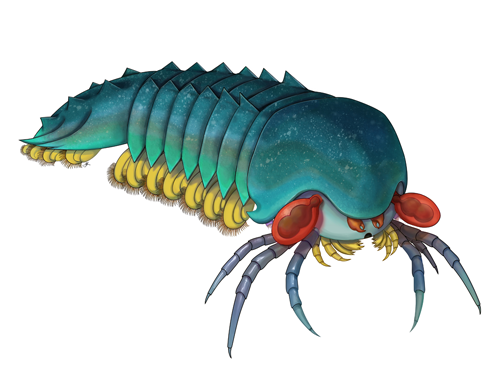Half-a-Billion-Year-Old Tiny Predator Unveils the Rise of Scorpions and Spiders
Published
Category
Press Release

TORONTO, September 11, 2019 — Two palaeontologists working on the world-renowned Burgess Shale have revealed a new species, called Mollisonia plenovenatrix, which is now considered to be the oldest chelicerate. This discovery places the origin of this vast group of animals—of over 115,000 species, including horseshoe crabs, scorpions and spiders—to a time more than 500 million years ago. The findings are published in the prestigious journal Nature on September 11, 2019.
Mollisonia plenovenatrix would have been a fierce predator—for its size. As big as a thumb, the creature boasted a pair of large egg-shaped eyes and a “multi-tool head” with long walking legs, as well as numerous pairs of limbs that could all-together sense, grasp, crush and chew. But, most importantly, the new species also had a pair of tiny “pincers” in front of its mouth, called chelicerae. These types of appendages, which are mainly used to hold and kill preys, are found only in chelicerates, a large group of arthropods which include modern scorpions and spiders.
“Before this discovery, we couldn’t pinpoint the chelicerae in other Cambrian fossils, although some of them clearly have chelicerate-like characteristics,” says lead author Cédric Aria, a member of the Royal Ontario Museum’s Burgess Shale expeditions since 2012, and is presently a post-doctoral fellow at the Nanjing Institute of Geology and Palaeontology (China). “This key feature, this coat of arms of the chelicerates, was still missing.”
Other features of this fossil, including back limbs likened to gills, further suggest that Mollisonia was not a “primitive” version of a chelicerate, but that it was in fact already close morphologically to modern species.
“Chelicerates have what we call either book gills or book lungs,” explains Aria. “Their respiratory organs are made of many collated thin sheets, like a book. This greatly increases surface area and therefore gas exchange efficiency. Mollisonia had appendages made up with the equivalent of only three of these sheets, which probably evolved from simpler limbs.”
The authors believe that Mollisonia preferentially hunted close to the sea floor, thanks to its well-developed walking legs, a type of ecology called benthic predation. Mollisonia’s “modern” features indicated that chelicerates’ seem to have prospered quickly, filling in an ecological niche that was otherwise left poorly exploited by other arthropods at that time. The authors conclude that the origin of the chelicerates must lie even deeper within the Cambrian, when the heart of the “explosion” really took place.
“Evidence is converging towards picturing the Cambrian explosion as even swifter than we originally thought,” says Aria. “Finding a fossil site like the Burgess Shale at the very beginning of the Cambrian would be like looking into the eye of the cyclone.”
The importance of the Burgess Shale and similar deposits, such as the Chengjiang biota in China, lies in their exceptional preservation of the earliest marine animal communities at a time of uniquely rapid diversification of body forms called the “Cambrian explosion.” Fossil animals from these sites are notable for preserving an extensive array of morphological features, such as limbs and eyes, but also guts and, much more rarely, nervous system tissues.
Mollisonia was first described more than a century ago by the discoverer of the Burgess Shale, Charles Doolittle Walcott. However, so far, only rare exoskeletons of this animal were known. “It is the first time that evidence of the limbs and other soft-tissues of this type of animal are described, which were key to revealing its affinity,” says co-author Jean-Bernard Caron, Richard M. Ivey Curator of Invertebrate Palaeontology at the Royal Ontario Museum (Canada). The exceptionally well-preserved fossils come from a new Burgess Shale site near Marble Canyon, in Kootenay National Park, British Columbia.
“Marble Canyon is the biggest spotlight of my career so far. This area keeps giving us wonderful treasures year after year,” says Caron, who has been leading the Royal Ontario Museum’s Burgess Shale expeditions for the past 10 years. “I would not have imagined that we could, in a way, rediscover the Burgess Shale like this, a hundred years later, with all the new species we are finding.”
The specimens of Mollisonia plenovenatrix described in this new research are better preserved than the ones found at the original Walcott quarry that is located about 40 kilometers northwest of the Marble Canyon quarry. Many other fossils found at Marble Canyon and surrounding areas have already played a critical role in our understanding of the early evolution of many animal groups. These notably include the vertebrates, our own lineage, thanks to numerous and exceptionally well-preserved specimens of the primitive fish Metaspriggina walcotti. Many new species await to be described; the latest one, a “flying saucer-like” new predatory arthropod with huge rake-like claws called Cambroraster falcatus, was just recently published on July 31, 2019.
The Burgess Shale fossil sites are located within Yoho and Kootenay national parks and are managed by Parks Canada. Parks Canada is proud to work with leading scientific researchers to expand knowledge and understanding of this key period of earth history and to share these sites with the world through award-winning guided hikes. The Burgess Shale was designated a UNESCO World Heritage Site in 1980 due to its outstanding universal value and is now part of the larger Canadian Rocky Mountain Parks World Heritage Site.
Mollisonia will be among the many exceptional fossils from the Burgess Shale planned to be on display in the ROM’s future new gallery, The Willner Madge Gallery, Dawn of Life, scheduled to open in 2021.
Major funding support for the research and field work came from the Royal Ontario Museum (Research and collection grants, Natural History field work grants), the Polk Milstein Family, the National Geographic Society (#9475-14 to JBC), the Swedish Research Council (to Michael Streng), the National Science Foundation (NSF-EAR-1554897) and Pomona College (to Robert R. Gaines). Research was also supported by Caron’s NSERC Discovery Grant (#341944) and the Dorothy Strelsin Foundation (ROM). Aria’s research at the Nanjing Institute of Geology and Palaeontology is supported by a President's International Fellowship Initiative Grant (#2018PC0043) and a China Postdoctoral Science Foundation Grant (#2018M630616).
- 30 -
ABOUT THE ROM
Opened in 1914, the Royal Ontario Museum showcases art, culture and nature from around the world and across the ages. Among the top 10 cultural institutions in North America, Canada’s largest and most comprehensive museum is home to a world-class collection of 13 million art objects and natural history specimens, featured in 40 gallery and exhibition spaces. As the country’s preeminent field research institute and an international leader in new and original findings, the ROM plays a vital role in advancing our understanding of the artistic, cultural and natural world. Combining its original heritage architecture with the contemporary Daniel Libeskind-designed Michael Lee-Chin Crystal, the ROM serves as a national landmark, and a dynamic cultural destination in the heart of Toronto for all to enjoy.
ABOUT THE NANJING INSTITUTE OF GEOLOGY AND PALAEONTOLOGY
The Nanjing Institute of Geology and Paleontology, part of the Chinese Academy of Sciences, was formally founded on May 7, 1951, with its root in the former Paleontological Section of the Institute of Geology (Academia Sinica) and in the Paleontological Group of the Geological Survey of China. It is the only academic institution specialized in invertebrate palaeontology and palaeobotany in China and the largest of such research organization in Asia, attracting numerous collaborators across the world. One of the key research areas of the Institute is the study of the Chengjiang Biota.
David McKay
Communications Coordinator
Royal Ontario Museum
davidm@rom.on.ca


